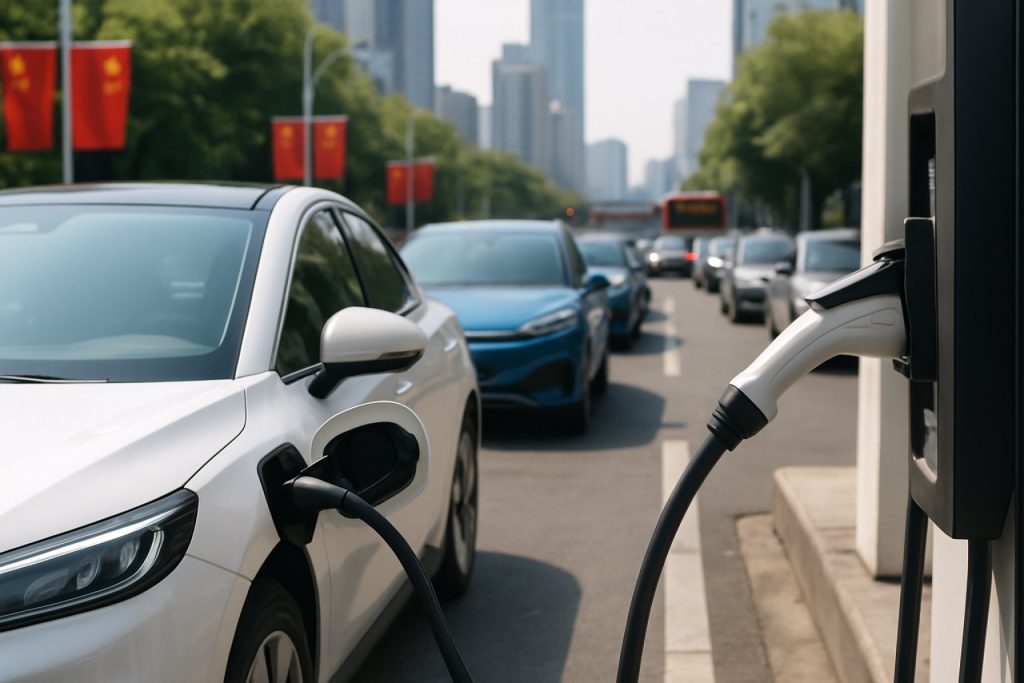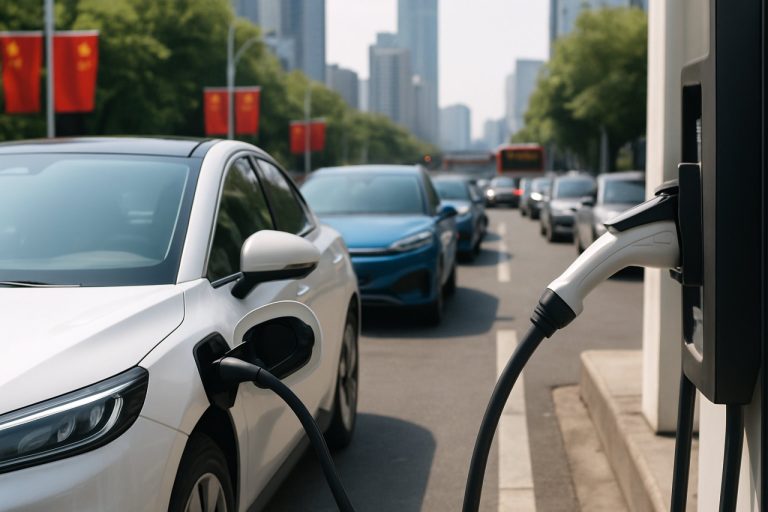
- China has become the world’s top passenger car exporter, shipping nearly 5 million vehicles in 2024.
- Chinese electric vehicle brands like BYD, NIO, and Xpeng are rapidly expanding across Europe, the Middle East, and beyond.
- BYD has overtaken Tesla as the leading global EV seller, highlighting China’s dominance in electric mobility.
- Over 60% of all electric vehicles sold worldwide are produced by Chinese manufacturers.
- Chinese automakers are projected to capture one-third of the global car market by 2030, driven by innovation in battery and smart car technology.
Clouds drift over glittering factories in the heart of Shenzhen and Shanghai, each one humming with the energy of transformation. Out of these assembly lines roll vehicles wearing unfamiliar badges—BYD, NIO, Xpeng, Zeekr—names that, just a decade ago, barely registered with drivers outside China. Yet today, their presence surges on highways from Oslo to Abu Dhabi, reshaping not only what the world drives, but who shapes the future of mobility.
A little over twenty years ago, China stood as a modest player in global car sales, with fewer than 10 million passenger vehicles navigating its vast landscape. Those numbers echoed a century-old America still in the shadow of the Model T. Now, China’s transformation stuns the imagination: its appetite for cars and its command of automotive innovation have elevated the nation from a net importer to the single largest exporter of vehicles worldwide. In 2024, China exported nearly 5 million passenger cars, a staggering 20% jump from the previous year, while car imports more than halved from their peak in 2017.
Walk through any major car show today and the invasion is unmistakable. The logos—AION, Clever, Maxus, Neta, Yangwang—curate an alphabet of ambition, each offering electric curves and AI-powered smart interiors. BYD stands out as the world’s current EV titan, edging past American stalwart Tesla for two consecutive quarters. In the first three months of this year alone, BYD sold over 416,000 electric cars globally, growing their volume by 38%, while Tesla stumbled with a 13% decline, delivering 336,681 cars.
But it’s not just about raw numbers. Two-thirds of the global electric vehicle market now flows through China—62% of EVs sold worldwide originate from Chinese factories. Consulting giant AlixPartners forecasts Chinese automakers will claim one-third of the entire global car market by 2030. European drivers stroll into chic showrooms and size up NIO sedans in Berlin, Oslo, or Tel Aviv, as Chinese EV makers plant their flags in six European countries, Israel, and the UAE. Each vehicle, with its seamless software, agile range, and competitive pricing, subtly sidesteps the old-world dominance of Detroit, Stuttgart, and Tokyo.
The global rise of these brands is fueled not just by scale, but by a relentless push for innovation. Chinese firms invest heavily in battery technology, autonomous driving, and user-centric design. They have shattered the notion that quality and digital sophistication belong solely to legacy automakers of the West.
The world’s roads tell a new story—one where electric dreams are crafted in sprawling Chinese cities, shipped by the millions, and driven into the hearts of countries everywhere. For consumers and competitors alike, the message is clear: The future of driving is no longer written in Detroit or Wolfsburg, but in the electric corridors of a rapidly transforming China.
- China now leads global passenger car exports, with about 4.9 million shipped in 2024.
- BYD has surpassed Tesla as the world’s largest EV seller, maintaining that lead for two quarters running.
- Chinese automakers are expected to command 33% of the global car market by 2030, per industry forecasts.
- Nearly two-thirds of all EVs sold worldwide are made in China.
Takeaway: In this new era, every electric mile is shaped by the relentless ascent of Chinese innovation, rewriting the map of the auto industry before our eyes.
The Silent Revolution: How Chinese EV Titans Are Set to Dominate Your Garage by 2030
China’s Automotive Power Surge: The Global Impact of BYD, NIO, Xpeng & More
In recent years, the global automotive landscape has shifted dramatically, with Chinese electric vehicle manufacturers such as BYD, NIO, Xpeng, and Zeekr becoming household names across continents. The export of nearly 5 million Chinese passenger vehicles in 2024 marks more than just a numerical milestone—it’s a revolution fueled by aggressive innovation, competitive pricing, and a bold vision for the future of mobility.
Let’s dive deeper into the factors driving this transformation, market trends, challenges, real-world usage, and expert-backed predictions to help you navigate this EV revolution.
—
1. Beyond the Headlines: Additional Facts about China’s EV Industry
a. Battery Tech Leadership:
Chinese carmakers, led by CATL and BYD, dominate the global lithium-iron-phosphate (LFP) and nickel-manganese-cobalt (NMC) battery space. These companies deliver batteries not only to homegrown automakers but also supply major Western brands like BMW, Tesla, and Volkswagen (source: International Energy Agency, IEA).
b. Manufacturing Scale and Vertical Integration:
Chinese automakers operate on unmatched scales, enabling lower production costs and faster innovation cycles. For example, BYD controls its own battery production, chip design, and even train and monorail businesses (source: BYD). This vertical integration allows for rapid model updates and robust supply chain resilience.
c. Smart Software & Over-the-Air (OTA) Updates:
Chinese EVs routinely offer advanced driver assistance systems, voice assistants, seamless app integration, and frequent OTA software updates—features sometimes lacking in rival non-Chinese brands.
d. Advanced Charging Infrastructure:
China is home to the world’s largest and fastest-growing network of public EV charging stations with over 2.7 million chargers nationwide, compared to less than 200,000 in the U.S., per BloombergNEF.
e. Niche Market Penetration:
Brands like Wuling (a SAIC-GM joint venture) produce compact, ultra-affordable EVs—the best-selling being the Hongguang Mini EV, costing less than $5,000 in China.
f. Focus on Sustainability:
Chinese policies actively incentivize battery recycling and green supply chains, mandating sustainable practices for manufacturers. Many plants run partly on renewable energy.
—
2. Real-World Use Cases & How-To: Owning a Chinese EV Abroad
Buying a Chinese EV as a European or Middle Eastern Consumer:
– Visit authorized showrooms (NIO, BYD, etc.) in major cities: Oslo, Berlin, Tel Aviv, Abu Dhabi.
– Most models feature robust warranty terms—often 6-8 years for batteries and electric components.
– Many dealerships provide home charger installation and software onboarding.
Life Hacks:
– Use manufacturer apps for remote climate control, trip planning, and battery pre-conditioning to maximize range.
– Leverage partnership incentives—like free public charging or cloud entertainment subscriptions.
—
3. Market Forecasts & Industry Trends
– Growth Rate: IEA projects that by 2030, 60% of cars sold globally could be electric—of which Chinese brands may capture one-third.
– Export Destinations: While Europe sees the most significant influx, Latin America, South Asia, and Africa are rapidly becoming major target markets for affordable Chinese EVs.
– Technology Race: Chinese firms will likely outpace Western counterparts on solid-state battery commercialization before 2027 (source: McKinsey).
—
4. Reviews & Comparisons
– BYD Seal vs. Tesla Model 3: The BYD Seal rivals the Tesla Model 3 in range (up to 570km WLTP), offers superior rear-seat legroom, but at a lower starting price point.
– NIO ET7 vs. Mercedes EQE: NIO’s flagship sedan is praised for its luxurious interiors, long-range battery swapping capability, and advanced AI, rivaling or surpassing German luxury EVs on tech and comfort at a reduced cost.
—
5. Controversies & Limitations
– Geopolitical Tensions: Trade tariffs and regulatory scrutiny in the US and EU could restrict Chinese EV imports.
– IP and Data Security: Some markets express concerns over data privacy as vehicles are equipped with extensive telemetry and smart features.
– Service Network: After-sales service and parts availability remain patchy in some export markets.
– Brand Recognition: Some consumers remain wary due to limited history outside China.
—
6. Key Features, Specs & Pricing
– Pricing: Chinese EVs are often 10–30% cheaper than equivalent Western models, primarily due to lower production costs and local resource access.
– Specs: Most new models offer ranges of 400–700 km, fast DC charging, Level 2+ ADAS, and upscale interiors.
– Connectivity: Nearly all come with 4G/5G, app integration, adaptive navigation, and real-time diagnostics.
—
7. Security & Sustainability
Chinese EV brands are aligning with global cybersecurity and safety norms, aiming for Euro NCAP 5-star ratings. Battery reuse, ethical material sourcing, and a push for carbon neutrality in factories are central to their strategies.
—
8. Expert Insights & Predictions
– “Chinese EVs will reshape retail, infrastructure, and policy discussions globally—within a decade they will normalize affordable, connected electric mobility.”
– Prof. Michael Dunne, Dunne Insights
– Compatibility: Most Chinese EVs support CCS2 charging standards, making them plug-and-play for European infrastructure.
—
9. Pros & Cons Overview
Pros:
– Unbeatable pricing and value for money
– Innovative design and infotainment
– Long range and robust battery life
– Rapid production scale-up and model refreshes
Cons:
– Inconsistent brand reputation outside Asia
– After-sales service networks still developing in some regions
– Geopolitical restrictions may limit access in certain markets
—
10. Frequently Asked Questions
Q: Are Chinese EVs safe?
A: Major brands meet or exceed Western crash safety standards (Euro NCAP, C-NCAP). Battery safety technology is world-leading.
Q: How do warranties compare?
A: Most leading brands offer warranties equal to or longer than Western rivals—typically 3–5 years overall, up to 8 years for batteries.
Q: Can I charge a Chinese EV at standard stations in Europe or the Middle East?
A: Yes. Most Chinese vehicles use the global CCS2 fast-charging standard.
Q: Will Chinese EVs hold their value?
A: Resale values are rising along with brand recognition but remain variable compared to established brands.
—
Actionable Quick Tips for Interested Buyers
– Research Local Warranty & Service Options: Make sure regional support is available before buying.
– Take Advantage of Tax Incentives: Many countries offer generous EV purchase rebates and tax credits.
– Test Drive Multiple Brands: Experience the differences in smart features, range, and comfort.
– Stay Informed on Import Policies: Regulations can change quickly; subscribe to updates from trusted automotive news portals.
—
Conclusion
China’s EV juggernaut—led by BYD, NIO, Xpeng, Zeekr, and others—is not just flooding highways with vehicles; it’s rewriting the rules of the car industry. The blend of affordable technology, design flair, and relentless innovation ensures that for consumers worldwide, the future of driving is electric…and very likely, made in China.
For more on cutting-edge electric vehicles and technology, visit BYD’s official site or learn from the global impact of Tesla.
The smart money is on the rise of Chinese EVs—will your next car be part of this silent revolution?



